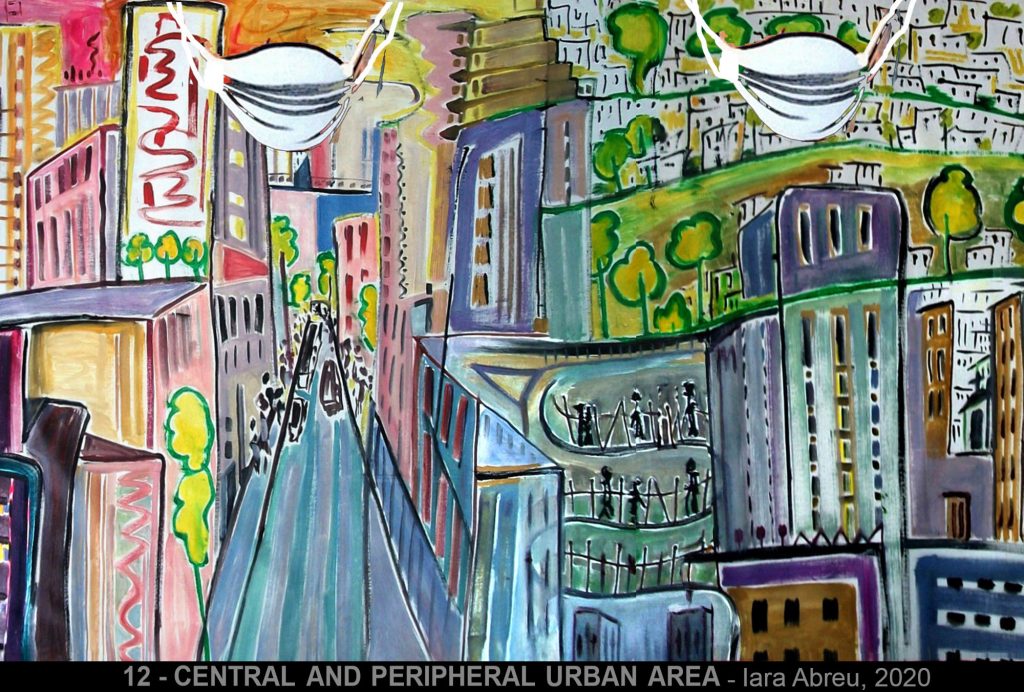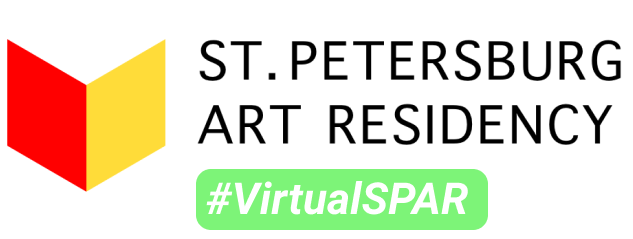URBAN ASPECTS / Quarantine – 12 Iara Abreu

This is the profile of the big cities in the capitalist universe. The dwellings are very distinct as in the image: central area – privileged noble areas and peripheral areas, workers, where usually reside low-income people and workers, informal or not; people on the margins of society and opportunities, excluded, without access to education, health and culture. And in times of isolation and pandemics, people from the poorest classes suffer the most.
And in this pandemic virus context, no one is saved from belonging to the risk group. All are leveled to the same level of isolation, restrictions and behavior… Maybe this moment wants to teach us something…
This image is one of the scenes of the large panel “Urbe” 2005 (100 cm x 11 meters), made for the first exhibition of the project URBAN ASPECTS.
12 – ÁREA URBANA CENTRAL E PERIFÉRICA
Esse é o perfil das grandes cidades, no universo capitalista. As moradias são bem distintas como na imagem: área central – áreas nobres privilegiadas e áreas periféricas, operárias, onde normalmente residem as pessoas de baixa renda e trabalhadores, informais ou não; pessoas à margem da sociedade e das oportunidades, excluídas, sem acesso à educação, saúde e cultura. E em tempo de isolamento e de Pandemias, as pessoas de classes mais pobres são as que mais sofrem as consequências.
E nesse contexto virótico pandêmico, ninguém se salva de pertencer a grupo de risco. Todos ficam nivelados a um mesmo patamar de isolamento, de restrições e de comportamento… Talvez esse momento queira nos ensinar alguma coisa…
Esta imagem é uma das cenas do grande painel “Urbe” de 2005 (100 cm x 11 metros), feito para a primeira exposição do projeto ASPECTOS URBANOS.
https://iaraabreu.blogspot.com/
You Might Also Like:
Van Luong (1)
 Kjell Zillen (4)
Kjell Zillen (4) Mels Dees (9)
Mels Dees (9) Gao Yu (4)
Gao Yu (4)Katya Lebedev (1)
Juan Dies (1)
 Anastasia Prahova (2)
Anastasia Prahova (2)Nena Nastasiya (7)
Taarn Scott (6)
 Cynthia Fusillo (20)
Cynthia Fusillo (20)Roberta Orlando (8)
 Nanda Raemansky (25)
Nanda Raemansky (25) Eliane Velozo (22)
Eliane Velozo (22)Leyya Mona Tawil (1)
Julia Dubovyk (2)
Jianglong (2)
 Iara Abreu (23)
Iara Abreu (23) Agathe Simon (1)
Agathe Simon (1)Rosetta Allan (1)
Elizaveta Ostapenko (5)
 Valentin Boiangiu (2)
Valentin Boiangiu (2) Wesley John Fourie (9)
Wesley John Fourie (9) Renato Roque (3)
Renato Roque (3)Rosa Gauditano (5)
Neerajj Mittra (34)
Ciana Fitzgerald (5)
Boris Moz (3)
 Katerina Muravuova (5)
Katerina Muravuova (5)Kyla Bernberg (1)
 Muyuan He (1)
Muyuan He (1)Liza Odinokikh (2)
 Amalia Gil-Merino (2)
Amalia Gil-Merino (2)Paulo Carvalho Ferreira (6)
 Anastasiia Komissarova (2)
Anastasiia Komissarova (2) Yumiko Ono (1)
Yumiko Ono (1) Stefania Smolkina (1)
Stefania Smolkina (1)Lena Adasheva (1)
 Zahar Al-Dabbagh (1)
Zahar Al-Dabbagh (1) Emily Orzech (6)
Emily Orzech (6) Fernanda Olivares (5)
Fernanda Olivares (5) Noor van der Brugge (3)
Noor van der Brugge (3) Ira Papadopoulou (2)
Ira Papadopoulou (2) Tom Chambers (8)
Tom Chambers (8) Titi Gutierrez (3)
Titi Gutierrez (3) Franz Wanner (2)
Franz Wanner (2) Crystal Marshall (6)
Crystal Marshall (6) Transpositions III (36)
Transpositions III (36) Riddhi Patel (3)
Riddhi Patel (3) Michele Kishita (2)
Michele Kishita (2)Damian Carlton (4)
 Deanna Sirlin (1)
Deanna Sirlin (1) Laura Salerno (3)
Laura Salerno (3) Nina Annabelle Märkl (12)
Nina Annabelle Märkl (12) Elina Fattakhova (1)
Elina Fattakhova (1) Tasha Hurley (1)
Tasha Hurley (1) Ian Hartley (2)
Ian Hartley (2) Laurence de Valmy (2)
Laurence de Valmy (2) Ilia Bouslakov (5)
Ilia Bouslakov (5) Andrea Ahuactzin Pintos (4)
Andrea Ahuactzin Pintos (4) Sveta Nosova (3)
Sveta Nosova (3)Carlos Carvalho (1)
 Maria Timofeeva (1)
Maria Timofeeva (1) Jinn Bug (2)
Jinn Bug (2) Johannes Gerard (3)
Johannes Gerard (3)Irène Mélix (1)
 Aba Lluch Dalena (3)
Aba Lluch Dalena (3) Fabian Reimann (1)
Fabian Reimann (1)Natalia Gourova (1)
 Kate Finkelstein (4)
Kate Finkelstein (4)Raina Greifer (1)
James McCann (2)
Naza del Rosal Ortiz (1)
 Jay Critchley Jay Critchley (1)
Jay Critchley Jay Critchley (1) Vicky Clarke (4)
Vicky Clarke (4) Maria Silva (4)
Maria Silva (4) Shir Cohen (5)
Shir Cohen (5) Peter Shenai (4)
Peter Shenai (4) Bo Choy (4)
Bo Choy (4)Alina Orlov (2)
 Olga Popova (3)
Olga Popova (3) Coco Spencer (2)
Coco Spencer (2) Filippo Fabbri (2)
Filippo Fabbri (2)Daniele Leonardo (5)
 SISTERS HOPE (1)
SISTERS HOPE (1) Scenocosme : Gregory Lasserre & Anais met den Ancxt (4)
Scenocosme : Gregory Lasserre & Anais met den Ancxt (4) Anne Fehres & Luke Conroy (6)
Anne Fehres & Luke Conroy (6) Olesya Ilenok (2)
Olesya Ilenok (2) Marie-Eve Levasseur (4)
Marie-Eve Levasseur (4) Natalia Tikhonova (2)
Natalia Tikhonova (2)Ildar Iakubov (1)
 Evgeniy Lukuta (7)
Evgeniy Lukuta (7) Jarkko Räsänen (5)
Jarkko Räsänen (5)Maria Guta (6)
Egle Kulbokaite Dorota Gaweda (6)
Thomas Kotik (1)
 Andrea Stanislav (3)
Andrea Stanislav (3)Ludmila Belova (1)
Alena Levina (1)
 Ilia Symphocat (2)
Ilia Symphocat (2)Yevgeniy Fiks (1)
Star Smart(Formerly Trauth) (18)
Jyoti Arvey (1)
Les Joynes (2)
 Ekaterina Ivanova (1)
Ekaterina Ivanova (1) Lev Shusharichev (1)
Lev Shusharichev (1)Michael Stebackov (5)
Ryan Griffith (3)
Lidia Gordeenko (3)
 Masha Danilovskaya (7)
Masha Danilovskaya (7) Irina Korotkaya (2)
Irina Korotkaya (2) WagtailFilms Oksana Bronevitskaia&Dmitry Zhukov (5)
WagtailFilms Oksana Bronevitskaia&Dmitry Zhukov (5)Kostya Diachkov (1)
Elena Sokolova (3)
Alexander Nikolsky (2)


8 Comments
Dear Iara,
I also thought about it: in Russia many people are dying from HIV/AIDS (“37 thousand deaths from AIDS in 2018”) and tuberculosis (8,1 thousand deaths in 2018), but it is not a problem of the “society” because it is not a disease of rich citizen of Moscow.
(https://en.wikipedia.org/wiki/HIV/AIDS_in_Russia
https://ru.wikipedia.org/wiki/Туберкулёз_в_России#Современная_ситуация)
And now everybody in Russia should be careful – say our federal newspapers and TV channels which are creating in the biggest cities – about Corona.
By the way many Russians do not live until 60 years to be in risk group… (https://en.wikipedia.org/wiki/List_of_federal_subjects_of_Russia_by_life_expectancy)
I think class aspect of this crisis will be researched soon!
Dear Nazar Niazmetov,
I had no idea that in Russia the situation about HIV was so serious. How sad. And as for Corona in the upper classes or the rich, one has to think yes, because the virus does not choose social class, nor race. It affects everyone and I think yes, the world will have to rethink the situation of very poor people in society. Otherwise we could have a viral spread in humanity with grave consequences.
Hug
Thank you for your reply!
I read more about Brazilian situation with coronavirus… We should redefine as minimum what is good medical insurance for us and pay more attention to this sphere because a lot of problems as far as I understand goes from trying to save money.
I hope you are in safety.
Have you already told about your art technique?
What media do you use: is it aquarelle on paper?
We expect our government to take action on public health. And I am in the second area, where there is a great incidence of coronavirus. But I take my care and so far I am very well.
As for my technique, I work several artistic segments like oil painting, I make objects in wood, drawing, illustrious books and others.
These posts for the Residency/ SPAR project are rereadings of existing works with some interference that dialogue with the time of quarantine. All the images posted are creative interferences, which I made on existing images. Some are drawings on paper, others are dry pastel drawings on paper and some are oil painting on canvas. These interferences or Postcard type assemblies for the Residency project, are made with electronic equipment such as photoshop and Paint on existing images. I make adaptations that dialogue with my texts. And I’m really enjoying this artistic exchange.
Hug
Wow, I could not think about the complexity of the process – how multi-layered it is!
Is the oil painting popular in Brazil? How involved are “traditional” techniques into the so-called contemporary art process?
In Russia, we have a strange conflict between Western oriented curators and artists who speak international art diplomacy language and – post-soviet (social realism) traditionalists that loves oil and “classicism”.
Also, there are some applied artists and designers, but they mostly don’t want to discuss (what the true art is), they just make businesses 🙂
Do you collect postcards by the way?
Thanks for your answers
Oi Nazar
I like hybrid art. Mixing material techniques and languages, including creations with technological equipment. It depends on creation or context. And yes it can be composing layers.
I think like this: the artist has to be free in his creations and in the use of artistic techniques and languages. The artist can be academic (classical) when he wants and can be contemporary when necessary. You can even use the classic to compose a contemporary work. I think the artist can do everything in his language.
Here in Brazil there are artists from all segments and the oil is still popular yes. There are artists who work with acrylic paint and others. I use any and all material I have access to. I use a type of material, depending on the idea I will develop.
Yes, there are also discussions here the classic and the contemporary, but in reality they are very much in dialogue with market, business… these discussions are complex. I particularly think that the real artist is what he “does” without thinking about the “after”. He only cares about his creation. Out of market, out of business, out of curators, out of galleries, etc.
I’ve got some postcards that don’t make it to the collection, but I like them a lot. And so I’m doing my participation in Residency, with images in the format of postcards. Then I will organize them in an “object book”.
And thank you for the comments. Very important..
Hug
Thank you for your answers! I didn’t know some things before
Have a good day!
Very good when information is useful.